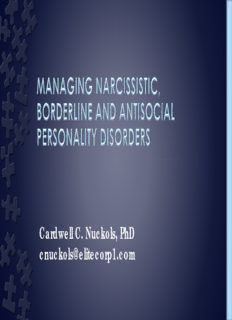
Borderline, Antisocial & Narcissistic Personality Disorders... PDF
Preview Borderline, Antisocial & Narcissistic Personality Disorders...
Cardwell C. Nuckols, PhD [email protected] • Totality of emotional and behavioral traits • Onset teens • Enduring, inflexible, consistent, and maladaptive • Causes significant impairment and/or distress • SOME SEEM TO GET BETTER IN THE 30 AND 40 YEAR OLD RANGE • Traits vs. Disorder • Personality (Cloninger, 1993) –Temperament -50% heavily influenced by genetics • Affective Tone • Intensity and Reactivity –Character -50% heavily influenced by environment • Moral and Value System • Temperament – Novelty-Seeking – Harm-Avoidance – Reward-Dependence – Persistence • Character – Self-Directedness (Responsible, Purposeful & Resourceful) – Cooperativeness – Self-Transcendence – Altruism › Genetics – Example-Antisocial Personality Disorder › Increased Impulsivity › Decreased Empathy › Low Frustration Tolerance › High Drive › High Sensation Seeking • Egosyntonic and Characterological • Character traits more amenable to treatment • Transference/Countertransference • Stress a variable in intensity • Psychotherapeutic Treatment Strategies –Increase acceptance and tolerance –Reduce intensity of trait expression –Promote adaptive trait-based behavior –REDUCE STRESS (REAL AND PERCEIVED) –Create conducive environments • Increase acceptance and tolerance – Psycho-education – Identify adaptive features • Reduce intensity of trait expression – Restructure triggering situations – Modify amplifying cognitions – Enhance incompatible behaviors – Medication • Promote adaptive trait-based behavior – How and when to ask for help • Create conducive environments – Modify environment to match client instead of asking the client to adapt to the environment that has been problematic › Help them find an environment they can flourish in – Especially true with Borderline PD › Set appropriate limits › Environmental Enrichment
Description: